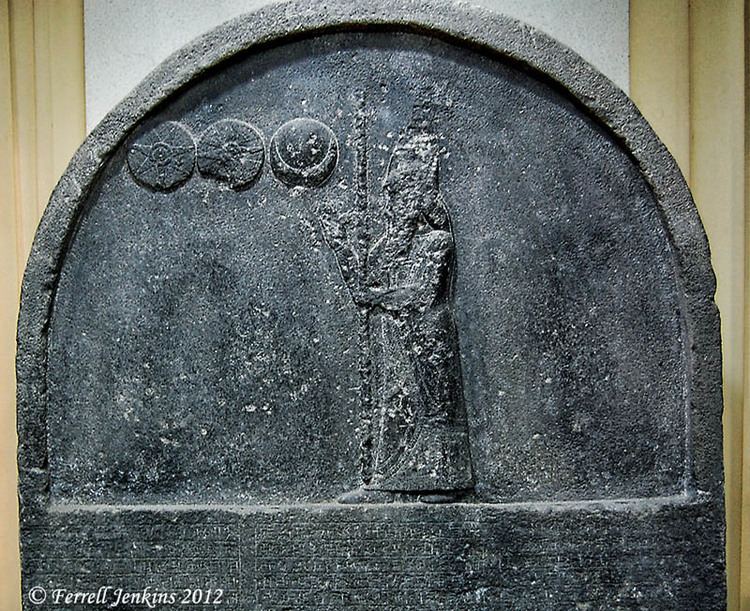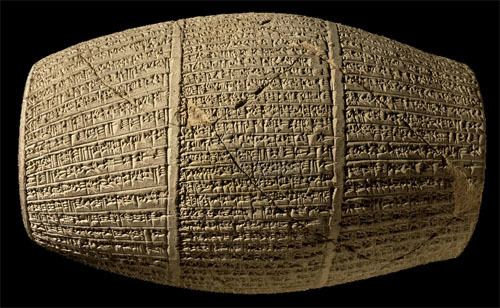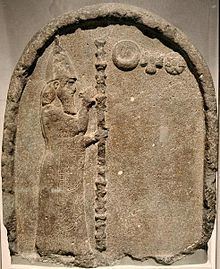Name Nabonidus Nabonidus Reign ca. 556–539 BC Successor Cyrus the Great Grandchildren Vashti | Died 539 BC Predecessor Labashi-Marduk | |
 | ||
Children Belshazzar, Nebuchadnezzar III People also search for Belshazzar, Cyrus the Great, Nebuchadnezzar III, Gobryas, Ennigaldi (Ennigaldi-Nanna) | ||
NABONIDUS MEDIA
Nabonidus (/ˌnaebəˈnaɪdəs/; Akkadian Nabu-naʾid, "Nabu is praised", نابونيد) was the last king of the Neo-Babylonian Empire, reigning from 556–539 BC.
Contents
- NABONIDUS MEDIA
- Historiography
- Ascent
- Reign
- Contributions
- Religious policy
- Nabonidus stay in Tayma
- The Persian conquest of Babylonia
- Death
- In popular culture
- References

Historiography

Modern perceptions of Nabonidus' reign has been heavily colored by accounts written well after his reign as king of Babylon, most notably by the Persians and the Greeks. As a result, Nabonidus has often been described in very negative terms in both modern and contemporaneous scholarship. However, an accumulation of evidence and a reassessment of existing material has caused opinions on Nabonidus and the events that happened during his reign to alter significantly in recent decades.
Ascent
Nabonidus' background is not clear. He said in his inscriptions that he was of unimportant origins. Similarly, his mother Addagoppe, who lived to an old age and may have been connected to the temple of the moon-god Sin in Harran, does not mention her family background in her inscriptions. There are two arguments for an Assyrian background: repeated references in Nabonidus' royal propaganda and imagery to Ashurbanipal, the last great Neo-Assyrian king; and Nabonidus' originating from, and his special interest in Harran, an Assyrian city and the last stronghold of the Neo-Assyrians after the fall of Nineveh, their main capital. However, it has been pointed out that Nabonidus' royal propaganda was hardly different from his predecessors, while his Persian successor, Cyrus the Great, also referred to Ashurbanipal in the Cyrus cylinder. He certainly did not belong to the previous ruling dynasty, the Chaldeans, of whom Nebuchadnezzar II was the most famous member. He came to the throne in 556 BC by overthrowing the young king Labashi-Marduk.
Reign
Nabonidus took an interest in Babylon's past, excavating ancient buildings and displaying his archeological discoveries in a museum. In most ancient accounts, he is depicted as a royal anomaly. Nabonidus is supposed to have worshiped the moon-god Sin beyond all the other gods, to have paid special devotion to Sin's temple in Harran, where his mother was a priestess, and to have neglected the Babylonian primary god, Marduk. He left the capital for the desert oasis of Tayma in Arabia early in his reign, from which he only returned after many years. In the meantime, his son Belshazzar ruled from Babylon.
Contributions
Nabonidus is most revered and is known as the first archaeologist. Not only did he lead the first excavations which were to find the foundation deposits of the temples of Samas the sun god, the warrior goddess Anunitu, (both located in Sippar), and the sanctuary of Naram-Sin, the moon god, located in Harran, but he also had them restored to their former glory. He was also the first to date an archaeological artifact in his attempt to date Naram-Sin's temple during his search for it. Even though his estimate was inaccurate by about 1500 years, it was still a very good one considering the lack of accurate dating technology at the time.).
Religious policy
Although Nabonidus' personal preference for Sin is clear, the strength of this preference divides scholars. While some claim that it is obvious from his inscriptions that he became almost henotheistic, others consider Nabonidus to have been similar to other Babylonian rulers, in that he respected the other cults and religions in his kingdom. His negative image could then be blamed on the Marduk priesthood, that resented Nabonidus' long absence from Babylon during his stay in Tayma, during which the important, Marduk-related New Year (Akitu-)Festival could not take place, and his emphasis on Sin. In any case, there is no sign of the civil unrest during his reign that would have been indicative of trouble.
Part of the propaganda issued by both the Marduk priesthood and Cyrus is the story of Nabonidus taking the most important cultic statues from southern Mesopotamia hostage in Babylon. This seems to be correct: a great number of contemporary inscriptions shows that these statues and their cultic personnel were indeed brought to Babylon just before the Persian attack:
"In the month of [Abu?] Lugal-Marada and the other gods of the town Marad, Zabada and the other gods of Kish, the goddess Ninlil and the other gods of Hursagkalama visited Babylon. Till the end of the month Ululu all the gods of Akkad -those from above and those from below- entered Babylon. The gods of Borsippa, Cutha, and Sippar did not enter."
However, modern scholarship has provided an explanation for this action. In Mesopotamia, gods were supposed to be housed inside their statues, from where they took care of their cities. But this only happened if they received the right kind of attention. So Nabonidus took special care of these statues and made sure that their cultic personnel had to come along with him. This was a long-standing tradition, too:
"One of the most powerful illustrations of the strength and conviction of image worship in ancient Mesopotamia is probably the treatment of cult statues in times of war. Assyrian and Babylonian sources of the first millennium frequently allude to the removal of divine statues from the temples as the result of a city being conquered. Spoliated statues were usually carried off to the land of the victorious power (Assyria in most known cases) where they remained in captivity until a turn of events would allow them to be restored to their shrines. (...) Rather than incur the capture of their gods and the resulting implications of such capture, namely, that the gods were abandoning the city and calling for its destruction, cities often tried to prevent the transfer of the statues to enemy territory, since continued possession of them in the face of adversity proved that the gods were still protecting and supporting their people and native land. (...) [D]uring the months which preceded the invasion and conquest of Babylonia by the Persians in 539 BC, King Nabonidus ordered a massive gathering of the gods of Sumer and Akkad into the capital. Unlike previous attempts, the gathering ordered by Nabonidus is documented by a number of historical and archival sources." [after this, Beaulieu goes on to discuss these sources in detail]
But this exposed him to criticism by his enemies, notably Cyrus, who was trying to show why he was a better king than Nabonidus had been, and took this as an example of Nabonidus lack of fitness to rule. In the words of, again, Beaulieu:
"The returning of the statues to their sanctuaries provided Cyrus with one of his many propagandistic anti-Nabonidus themes. Not content with re-establishing the gods in their residence, he charged the deposed king with having brought them to the capital against their will."
And in the words of Cyrus himself, as recorded on the Cyrus Cylinder, found in Babylon in 1879:
"As for the gods of Sumer and Akkad which Nabonidus, to the wrath of the lord of the gods, brought to Babylon, at the command of Marduk, the great lord, I (Cyrus) caused them to dwell in peace in their sanctuaries, (in) pleasing dwellings. May all the gods I brought (back) to their sanctuaries plead daily before Bel and Nabu for the lengthening of my days, may they intercede favorably on my behalf."
This is confirmed by the Babylonian Chronicles:
"From the month of Kislimu to the month of Addaru, the gods of Akkad which Nabonidus had made come down to Babylon, were returned to their sacred cities."
Nabonidus' stay in Tayma
It is not clear yet why Nabonidus stayed in Tayma for so long. His reason for going there seems clear: Tayma was an important oasis, from where lucrative Arabian trade routes could be controlled. The Assyrians before him had already attempted to do the same. However, why Nabonidus stayed for so long (probably about ten years, perhaps from 553–543 BC) and why he returned when he did remain unresolved questions. It has been proposed that this was because he did not feel at home in Babylon, which was opposed to his emphasis on Sin. Regarding his return, this may have had to do with the mounting threat of Cyrus and growing disagreements with Belshazzar, who was relieved of his command directly after Nabonidus had come back, along with a number of administrators. During his stay, Nabonidus adorned Tayma with a complex of royal buildings, most of which have come to light during recent excavations.
The Persian conquest of Babylonia
Different accounts of the fall of Babylon survive. According to the Cyrus Cylinder, the people opened their gates for Cyrus and greeted him as their liberator. Isaiah 40–55 prophesied that the Persians would carry off Babylonian women and cultic statues. Herodotus said that Cyrus defeated the Babylonians outside their city, after which a siege began. When this took too long, Cyrus diverted the Euphrates, so that his troops could march into the city through the river bed. Xenophon had a similar view, but he did not mention the battle. Finally, Berossus claimed that Cyrus beat the Babylonian army, but this time, Nabonidus was supposed to have fled to nearby Borsippa. There he hid, while Cyrus took Babylon and demolished its outer walls. When Cyrus turned towards Borsippa, Nabonidus soon surrendered.
As these accounts contradict each other, (the Cyrus Cylinder and Isaiah; for the latter, see Cyrus in the Judeo-Christian tradition), oral traditions (Herodotus and Xenophon) and conflicting records (Berossus), they are quite confusing. The Nabonidus Chronicle is more helpful. This is a part of the Babylonian Chronicles, which are concise, factual accounts of historical events, and are therefore considered to be very reliable, although not very informative. Regarding the capture of Babylon by Cyrus, this text says:
"In the month of Tasritu, when Cyrus attacked the army of Akkad in Opis [i.e., Baghdad] on the Tigris, the inhabitants of Akkad revolted, but he [Cyrus or Nabonidus?] massacred the confused inhabitants. The fifteenth day [12 October], Sippar was seized without battle. Nabonidus fled. The sixteenth day, Gobryas [litt: Ugbaru], the governor of Gutium, and the army of Cyrus entered Babylon without battle. Afterwards, Nabonidus was arrested in Babylon when he returned there. Till the end of the month, the shield carrying Gutians were staying within Esagila but nobody carried arms in Esagila and its buildings. The correct time for a ceremony was not missed. In the month of Arahsamna, the third day [29 October], Cyrus entered Babylon, green twigs were spread in front of him – the state of peace was imposed upon the city. Cyrus sent greetings to all Babylon. Gobryas, his governor, installed subgovernors in Babylon."
Additionally, a building inscription has been found which mentions the restoration of the Enlil Gate of Babylon shortly after its capture. Based on this information, the following reconstruction has been proposed: When Cyrus attempted to march into southern Mesopotamia, he was met by the Babylonians near Opis. In the ensuing battle, the Persians were victorious. This in turn led to the nearby city of Sippar surrendering. Meanwhile, the Babylonians had withdrawn south to establish a line of defence near the Euphrates that was intended to prevent Cyrus from advancing too far. However, Cyrus' forces did not challenge the Babylonian army. Rather, he sent a small force south along the Tigris to try to take the capital by surprise. This plan worked: the Persian troops reached Babylon undetected and caught it unawares, meeting only minor resistance near one of its gates. Thus, they were not only able to capture Babylon, but also King Nabonidus.
This left the Babylonian army in an untenable position and it soon surrendered. In the meantime, Ugbaru, the commander of the Persian forces that had captured Babylon, had taken good care that his men would not plunder or otherwise harm the city. He had even made sure that the temple rites continued to be observed. Nonetheless, it still took Cyrus almost a month before he proceeded towards the city. As many Babylonian officials as well as the Babylonian administrative system stayed in place after the transition of power, it has been surmised that this time was spent on negotiations with representatives from the city; this is similar to what happened when the Neo-Assyrian king Sargon II and later Alexander the Great took the city.
Death
The final fate of Nabonidus is uncertain. Cyrus was known to spare the lives of some kings he had defeated, for example King Croesus of Lydia, who, after his defeat, was allowed to live at King Cyrus's court as an advisor. This is according to Herodotus, who also states that Croesus was first sentenced to death by burning and was only allowed to live after showing his wisdom. Bacchylides tells us that Apollo snatched up Croesus just before the flames were about to burn him, and took him to the Hyperboreans. In the reference in the Nabonidus Chronicle to a campaign by Cyrus in (possibly) 547 BC, during which a country was taken and its king killed, the text showing the name of the country is damaged, although it may be Urartu. Accounts by Berossus and the retrospective Hellenistic Babylonian dynastic prophecies state that he was allowed to retire to live in Carmania.
